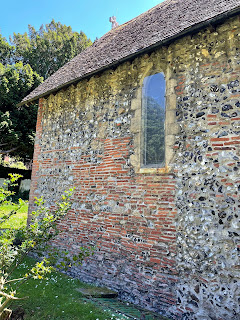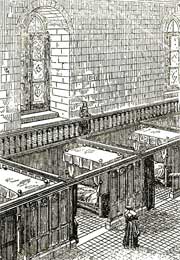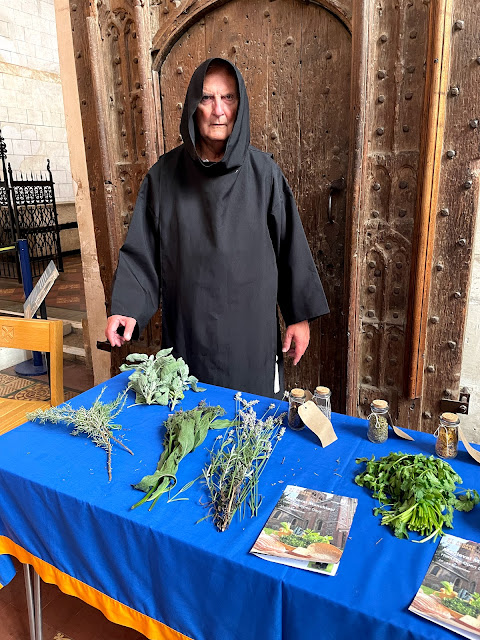We know that monks looked after their own health (see the last two posts) but how far did they help the sick in their local communities? Monasteries were expected to provide hospitality and help for pilgrims who became ill, but they did not cater for all the local sick. Yet did they provide some accommodation, perhaps for the privileged, or at least health advice? If we include the mendicant orders - the friars - the picture becomes more complex. We know that Augustinian canons often staffed the "hospitals" which were set up by wealthy patrons in our period just like monastic houses. There were Infirmaries for the public in some cenobitic communities (notably the Cistercians) but there far more establishments of varying size, title and personnel which could loosely be called hospitals. Definitions and boundaries for these are tricky and provision will have varied from area to area and at different times. I hope that the following overview will shed some light on this fascinating area of study.
.

We know that Benedictine infirmaries were set up to meet the needs of their own monks In the Rule of St Benedict it is not clear whether there was a duty of care for the sick in general. Herbal treatment and advice may have been given to local people but the idea of taking in the local sick to use the few valuable infirmary beds is mistaken. In later years wealthy clients may have paid for treatment in separate rooms but this will have been rare. Provision for the outside sick had to involve separate buildings and separate funding. This begins to look like the modern concept of a hospital.
It might seem logical that hospitals were founded to care for the sick and the physical relief of suffering. Monasteries were more concerned to intercede for the souls of the living and the dead. We must understand that there was a crossover because illness was connected to divine punishment, and hospitals saw a duty care of the soul as well as the body. In practice there was little if any difference between a monastic infirmary and a hospital because the care provided likely began with washing the patient, providing clean warm bed with prayers and a round of offices (standard monastic services)performed each day around them. The environment would appear to us like a church nave with beds and prayers and chanting going on.
Let's consider what we actually mean by Hospital? The term may have first been used in 1112. Hospes (Latin) means guest or stranger. The way they could be founded, their purpose and mode of operation varied. They can be divided into hospitals for lepers; short term hospitals for the sick poor resembling hospices for the dying, or for pilgrims who were sick ; and longer term care for the elderly infirm or disabled. There is no agreement on the number of hospitals from the late 11th century to the mid 16th century. It depends on how they are classified, but there could have been as many as 1500.Perhaps half of them were directly connected to monasteries, priories or churches. Hospitals could be founded by anyone with money, whether King, Church, nobility, urban corporation, guild and it is not easy to detect who actually founded many of them. A noble might found one in the hope of spending less time in Purgatory. A monastery might choose to become a patron of one in order to boost its own reputation.
To give some idea of the spread of involvement by the various monastic orders it has been calculated that in 1146 there were at least 69 hospitals attached or close to a monastic complex. (15 Benedictine, 2 Trinitarian, 2 Carthusian, 6 Cistercian, 6 Cluniac, 5 friaries, 4 Order of Holy Sepulchre, 24 canonries (Gilbertine, Augustinian, Premonstratensian),2 priory hospitals, 1 Order of St Thomas of Acon and 1 Order of St Lazarus of Jerusalem. These institutions were therefore staffed by a large variety of monks, friars and nuns.
 |
| Remains of St John's in Canterbury |
How did it all start? Archbishop Lanfranc founded St John's Hospital in the 1080s for the infirm, with 30 beds for men and separate section for women. A separate leper hospital, St Nicholas Harbledown, was also founded nearby by Lanfranc soon after. It is still known locally as the Leper Church. I recently visited this church - see the photos below
Other leper hospitals followed all over England built outside towns.
 |
| The remains of the leper house at Stourbridge |
There was a leper house at Stourbridge in Cambridgeshire built about 1125 which was used by them until the late 13th century. Miraculously the chapel has survived - obviously with restoration but it is pretty much inside and out as the lepers would have known it. The largest Cistercian monasteries sometimes did have an entirely separate Infirmary built to cater for the external sick.e,g, Rievaulx in Yorkshire, This seems bizarre to me because Cistercian sites were usually very isolated. The sick would have had to travel to them, and it was in the towns that care would have been more necessary. It is unclear how far treatment in these Cistercian lay hospitals went beyond care and shelter and included real medical interventions. There were medical men in monks and conversi but Gerald of Wales attacked some of these in the late 12 century for not having appropriate skills and therefore having bad results. From the account rolls at Beaulieu in 1270 we can deduce that inmates of the secular infirmary received daily broth from gruel, beer and small white loaf., meat, mainly mutton, with beans and peas, fish including herring, cod, hake, mackerel and this infirmary cost twice as much to run as the monks' infirmary. It was supported by bequests and donations.
If they were offshoots of an abbey or priory the hospitals would invariably be situated outside the main monastery campus. This was particularly true of Cistercian foundations. This was the case at Fountains Abbey in Yorkshire and Zwettl in Austria.. The lay infirmary at Tintern Abbey in Monmouthshire was a mile away. Zwettl in 1218 could cope with 30 needy infirm. Beaulieu in 1270 gave food and shelter at night for 16 poor men.
Whereas the Rule of St Benedict tied Benedictine monks down to a specific closed place , the Mendicant Orders were different. Their role was more hands on with the local community. So far in these posts I have hardly mentioned these Orders so it is time to briefly explain what they were about. Their main trademarks were poverty, ability to travel around, and live in urban areas in order to preach, evangelise and help the poor. They are often called friars, not monks, and usually did not answer to an abbot nor necessarily stay in one location. The four great Mendicant Orders were the Franciscans (often called Grey friars and founded 1209), the Dominicans (often called Black friars and founded 1215), the Augustinians (Austin friars founded in early 13th century) and Carmelites (White friars founded early 13th century). At first their houses were small but as they received donations, bequests, and sponsorship their buildings began to get larger and larger in towns. As for their attitude to public health it was their duty to visit the sick, especially the poor sick in their homes. Some Franciscans were physicians and treated their own members and some secular patients in the early 13th century and later on they may have acted as apothecaries.St Francis had conspicuously helped lepers as part of charity to the poor. Dominicans never considered physical care of the sick as part of their duty although there is some evidence that they treated secular patients in their infirmaries. How far the treatment in Mendicant infirmaries went beyond a clean warm bed and spiritual comfort is impossible to define.
Hospitals were founded to provide help for sick pilgrims or just accommodation for the night. The Maison Dieu at Ospringe, on the outskirts of Faversham, Kent, commissioned by King Henry III in 1234, was for travellers to the Continent to stay overnight, with chapel and food and bed for the night. The provision was both material and spiritual by Canons of the Order of the Holy Cross (or Crosiers founded in Belgium in 1210). The surviving building on the old A2 is only a small part of the original foundation. See plan below where it is to the bottom left and off the picture. The main buildings including the chapel and the Camera Regis where a King might stay are on the other side of the road and have completely disappeared. A Master and 3 Augustinian brethren would have staffed the hospital (or hostel) providing spiritual and some physical care. Endowments by wealthy benefactors helped to support the work. However the demands of Kings and other nobles with large retinues meant that demands exceeded what was available, and along with incompetent stewardship of resources, the facility struggled during the later Middle Ages.
 |
| Maison Dieu at Ospringe Kent |
Hospital buildings for the laity tended to follow the monastic pattern with the best drainage systems around and availability of water and toilets. Examples of these separate Major Hospital buildings included St Mary Spital in London, St Leonard's at York and Holy Trinity Soutra in Scotland. All three were run by Augustinian canons. St Mary Spital was on the site of the present Spitalfields Market in central London. It grew to 180 beds staffed by 12 lay brothers or sisters. For the interesting full story see here.
 |
| Conjectural view of St Mary Spital |
 |
| Hospital of St Cross at Winchester |
The hospital of St Cross at Winchester still survives today. The design of these mimiced to a large extent a normal abbey. with double quadrangle housing chapel and clergy in one and hospital in the other.
Hospitals seemed to have taken in both men and women and could be tended by men and women staff (monastic or lay) . St Mary Chichester gives a good impression of what a standard Infirmary would have looked like.
 |
| Plan of St Mary Chichester |
 |
| Interior view of St Mary Chichester |
To accommodate both men and women the layout would have required alteration. The Infirmary at St John the Baptist and St John the Evangelist at Sherbourne had a double decker arrangement with women on the top deck and men below. The women would have still been able to see Mass below without being seen from below. St Mary Spital in London may have been two storey too.
It appears that the number of hospitals declined later in the 14th century after the Black Death. Many surviving hospitals were small, perhaps meant for 12 inmates, and few had over 100 beds. Some cities had large numbers : London 35, including 9 for lepers, York had 35, Bristol 16, Norwich 15, Exeter 10 and Canterbury 9. but some of these were likely to have been like a hospice for 2 or 3 people.
What happened at the Dissolution of the monasteries? Perhaps half of the existng hospitals were closed following the King's audit in 1535 because they were run by monasteries or appeared to be like monasteries and fell into the category of having income of less than £200 a year. By 1540 the monasteries had disappeared through a piecemeal procedure of surrender and threat. Notably St Leonard's of York had also gone. More followed through the later 1540s as the King moved against collegiate churches and chantries. The great monastic and hospital foundations in and around the City of London emptied out and many became ruins by the reign of Queen Elizabeth.
Some sources
Ayliffe, W. St Bartholomew's Hospital and the origin of London Hospitals. (2008)
Bottomley, F. Abbey explorer’s guide (Otley, 1995)
Braun, H. English abbeys {London, 1971)
Clark, J.G. Benedictines in the Middle Ages (Woodridge, 2011)
Clark, J.G. and Preest, D. eds. Deeds of the Abbots of St Albans (Boydell Press, 2019)
Crossley, F.H. The English abbey 3rd ed, (London,1949)
Evans, J. The Romanesque architecture of the Order of Cluny (Cambridge, 1938)
Furniss, D.A. The Monastic contribution to medieval medical care. Journal of Royal College of Practitioners, 15 1968, 244-250.
Harvey, B. Living and dying in England 110-1540 the monastic experience. (Oxford, 1993)
Kerr, J. Life in the Medieval cloister (London, 2009)
Knowles, D. Religious Orders in England vol 1-3 (Cambridge, 2008)
Leroux-Dhuys, J-F. Cistercian abbeys : history and architecture (Cologne, 1998)
McAleavey, T. Life in a Medieval abbey (London, 1995)
Mahood, H. The liminality of care : caring for the sick and needy on the boundaries of monasteries. (University of Reading, 2015)
Mountford, A. Health, sickness, medicine and the friars in the 13 th and 14th centuries. (Abingdon, 2004)
Parry, A. ed. Rule of St Benedict (Leominster, 1990)
Rosewell, R The Medieval monastery (Oxford, 2011)
Whittock Life in the Middle Ages (2009)
Williams, D.H. The Cistercians in the early Middle Ages (1998)




























